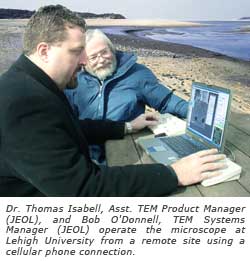 Peabody, Mass., April 17, 2006 — JEOL USA recently demonstrated a revolutionary remote capability for operating a transmission electron microscope (TEM) using a laptop computer with a cellular network connection. While seated at a picnic table 300 miles away, JEOL applications specialists manned the controls of a JEM-2200FS TEM operated at Lehigh University in Pennsylvania.
Peabody, Mass., April 17, 2006 — JEOL USA recently demonstrated a revolutionary remote capability for operating a transmission electron microscope (TEM) using a laptop computer with a cellular network connection. While seated at a picnic table 300 miles away, JEOL applications specialists manned the controls of a JEM-2200FS TEM operated at Lehigh University in Pennsylvania.
Untethered TEM operation is a unique capability from JEOL made possible with a simple instrument control knobset and laptop computer outfitted with a cellular communications card. While JEOL introduced remote TEM operation using a hardwired connection to the Internet last year in an enhancement known as Sirius, wireless broadband capability makes it possible to operate the microscope from non-traditional settings outside of the lab environment.
Wireless connection
The TEM at Lehigh University is remotely operated by microscopists at the NASA Goddard Space Flight Center outside of Washington, D.C. The instrument, located in the laboratory of Professor Christopher Kiely and maintained and operated by Dr. David Ackland, uses either an 18 Mbit OC3 commercial internet connection or a 100 Mbit Internet 2 connection.
TEM to go
“The concept of microscopy anywhere, a trademark of the JEOL Sirius Remote Control System for TEMs, has been taken to the next level,” says Dr. Michael Kersker, TEM product manager and vice president at JEOL USA in Peabody, Massachusetts. The TEM user can view atoms or cellular structures from any location where a wireless connection is obtainable. “Not only can you see atoms from thousands of miles away from the actual sample in the microscope, you can take the TEM controls with you anywhere — from the backseat of a taxi to a beach chair. It’s like having TEM to go.”
Isolate sensitive or hazardous processes
Remote TEM operation is already the norm in laboratories across the U.S. Oakridge National Laboratories has designed a TEM facility that isolates the TEM environment from motion and temperature changes for their sensitive processes. At the University of Texas Medical Branch, the newly-opened Biosafety Level 3 laboratory will allow scientists to remotely operate the cry-TEM to examine deadly viruses from outside the containment area or from halfway around the world. Remote operation makes it possible for universities and research labs to share microscope time with students or researchers from other organizations.
Now wireless broadband further expands the flexibility of JEOL TEM operation.
https://www.jeolusa.com/NEWS-EVENTS/Press-Releases/PostId/23/Untethered-TEM





